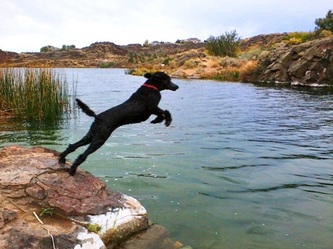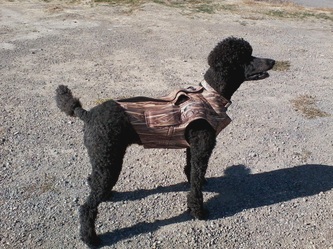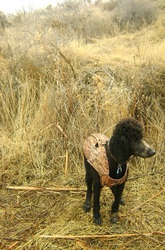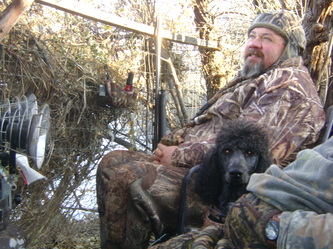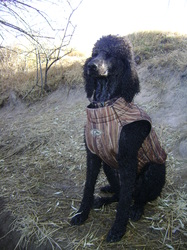'Poodle' originating from the German word "Pudeln", meaning: To Splash!

So, you're in need of a hunting compainion? You'd like it to have the capabilities of many breeds combined, such as the power of a lab in the water, the nose of a pointer in the field, the stamina of a Setter hunting upland game, the soft mouth of a Wirehair, a water repellant coat, and not to mention a good personality at home when not on the hunt. Today's breeds such as the Labrador Retriever, English Setter, Pointer, and the German Short & Wirehair all come to mind as first choice. Over time, due to their fancy looks, certain breeds have been pushed to the back burner as hunting companions, such as the Cocker Spaniel. With that said, I'd like to introduce you to the original Hunting Dog and Retriever, The Poodle. Worried what your buddies will think when you pull up and out jumps a 'foo-foo' looking poodle? Don't worry, the Poodle is also sweet enough the dry their tears at the end of the day when you two come home with the most game!

"The poodle has been around for a long time. Ancient Egyptian and Roman artifacts often depict the poodle's ancestors assisting their owners as they bring in game nets, herd a variety of animals or retrieve selected catches from various marshes. The poodle was originally bred to be a water dog -- retrieving game fowl trapped or shot down by its owners. In fact the name "poodle" is a derivative of the old German extraction "pudeln" which translates roughly as "to splash in water." One commonly held belief is that it descended from Asian herding dogs then traveled west with the Germanic tribes to eventually become a German water dog. "
-badasspoodle.com
-badasspoodle.com

"Unlike many other breeds of dog that were bred to specific sizes only within recent history, the poodle's three primary sizes -- toy, miniature and standard -- have been around for centuries. One of the most misunderstood aspects of poodles is why they are clipped in such an array of seemingly bizarre styles. The fact is that the distinctively shaved areas and tufts of hair - the unique poodle "look" -- are a direct result of the poodle's working and sporting heritage. In order to protect the poodle's vital organs and joints from the cold of constant water retrieval, certain areas were shaved for added mobility and to lessen the chance of snagging while other key areas were left densely covered for warmth. This reached a peak during the heyday of the French nobility. The French adopted the poodle with a special zeal and brought clipping to the level of high art. Even today, most people associate the poodle with France instead of Germany and have subsequently named the poodle, "the national dog of France." In French, they are called "Caniche" - a variation of the French word for duck - to reflect what Poodles were bred to retrieve. "
-badasspoodle.com
-badasspoodle.com
Poodles have worked in virtually every capacity a dog is capable of filling. From cart-pulling draught animal to parlour-room trickster, from sled dog to assistive guide dog, from warrior to rest-home companion, from truffle-hound to eminently competent bird dog, and from watchdog to show ring master, the poodle excels at everything it sets its mind to.

